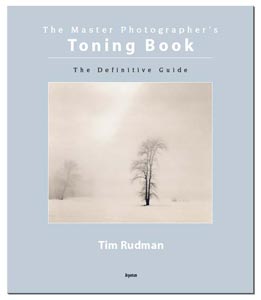'The Master Photographer's Toning Book'
(Previously 'The Photographer's Toning Book' in the USA)
'The Thousand Dollar Book' -- reprinted and re-launched - for just £25!
Sold out.
Currently only available on the second-hand market.

Since this book sold out both UK and US editions and the publisher decided not to reprint for a niche market, it has been commanding crazy prices for second hand copies on the internet. The highest I have seen was on Amazon for $1,333. Whilst this is clearly unusual the book is regularly advertised for several hundred $s or £s and I often received emails asking where it can be bought at cover price - which of course it couldn't.
In 2011 the rights reverted to me and in collaboration with Silverprint Ltd of London I arranged a reprint, ensuring the same high quality production as the original.
Despite inflation since this book was first printed in 2002 the original cover price has been held at £25.
"One of the best organised and most informative technical books on photography I have ever read." Unblinking Eye
Reviews and unsolicited comments
Photo Art International
A masterpiece. Comprehensive, practical, easily understood. Useful tips, inspiring images, previously well kept secrets. No darkroom worker should be without it
Better Photography (Australia)
For those who haven’t seen it yet, take it from Better Photography that this is a must-have publication for the serious darkroom worker.
Unsolicited emails and comments from the internet...
- 'Fantastic book that everyone should have'.
- 'It has to be the most comprehensive toning book ever'.
- 'Tim's book is the bible on toning'.
- 'I can honestly say that this is one of the most useful books on wet process printing that I have ever read'. (Amazon)
- 'Takes guts to include "The Definitve Guide" as the subtitle of a book. Question is, is it deserved? Answer a respounding YES! Am I surprised? Not when I see that the author is Tim Rudman'. (Amazon)
- 'Absolutely the best guide i have ever seen about archiving and toning photographs'. (Amazon)
- 'If you are a photographer, you need this book.' (Amazon)
- 'This book is suitable for both the Novice and Advanced photographic print maker and is the only book on toning that you are likely to ever need'. (Amazon)
Description
Synopsis
Describes both entry-level and advanced toning techniques for the creative photographer and printer. Each theme is expanded to include instructions and formulae for home-made toners.
Book Description
This sizeable book has over 200 pages containing over 365 images and about 140,000 words and describes both entry-level and advanced toning techniques for the creative photographer and printer.
A chapter is devoted to each toner, allowing readers to enter at the level appropriate to their experience and to then develop their skills as far as they want too. In the author’s words, ‘This is a book to grow into rather than grow out of'’.
Using a system of First Steps, Second Steps and Further Steps, the normal use of simple ‘off-the-shelf’ toning kits is explained and then developed further by exploring the more advanced and less familiar techniques for which they may be employed.
Each theme is then expanded to include instructions and formulae for home-made toners that both save money and further expand the reader's creative options.
Processes and techniques described include the use of all the common and less common toners both singly and in combination, multi toner kits, selective toning, archival and negative toning, simple and advanced uses of bleaches and developers, dyes and the use of less conventional materials such as tea and coffee.
Sections on print finishing and useful printing controls for toning are also included. Toned vs. untoned step wedges show the effect of each toner on highlight and shadow density and on contrast with different papers, in order to allow compensation at the printing stage for perfectly toned prints.
An invaluable reference, toners characteristics tables, colour/toner 'search' charts, frequently asked questions, formulary and DIY section is included.
280 mm x 240 mm
Stiff softback with flaps
ISBN 1 902538 23 4 (original); 978 1 902538 23 (new)
First published in Great Britain by Argentum, an imprint of Aurum Press Ltd, London.
Text & images (except wher otherwise specified) copyright 2002 by Tim Rudman.
Published in America by Amphoto.
A catalogue record for this book is available from the British Library.
Contents
Chapters:
Toning – general considerations
What’s going on?
Practical issues affecting toning
Sepia toning
Polysulphide-based toners (including Viradon, Poly-Toner and Brown toner)
Selenium toning
Gold toning
Blue toning
Copper toning
Green toning
FSA toning (a.k.a. thiourea dioxide or Manotone)
Silver and bronze mirror toners
‘Toning’ with tea, coffee and gelatine dyes
Selective toning
Multiple toning techniques
Multi toner kits
Toning & processing for archival permanence
Toning negatives
Print finishing
Useful printing controls for toning
Formulary
Glossary of terms
FAQs
Toner search by colour
Colour search by toner
Toner characteristics table
F-stop table
Making up solutions
Weights & measures
Temperature conversion table
Useful websites, internet discussion groups and references
Useful addresses